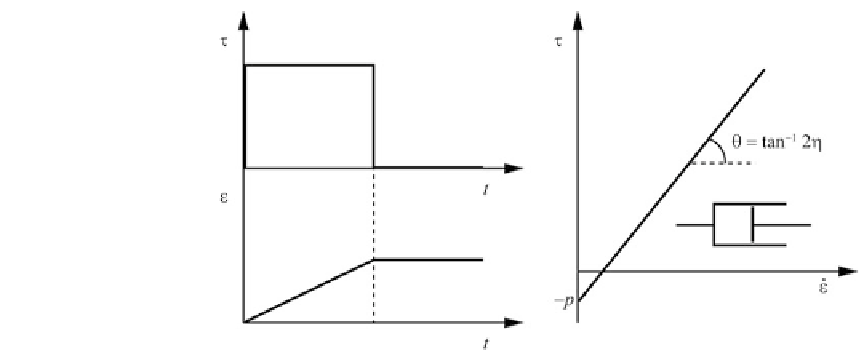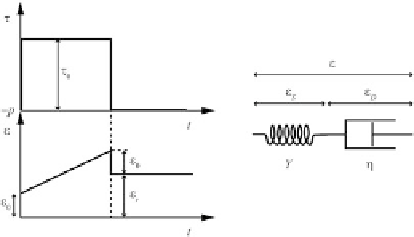Geology Reference
In-Depth Information
Fig. 7.10
Response of a
linear viscous system to a
stress step. An analog
model for this system is the
dashpot. There is
continuous deformation at
constant rate under
constant stress, and the
strain © is permanent after
stress removal
Another theoretical response of a material to
stress steps, which can eventually combine with
the elastic response, is associated with the
vis-
cous behavior
. In this instance, the constitutive
equation relating stress and stress expresses pro-
portionality between stress and
strain rate
rather
than strain:
£.t/
D
2ǜ
P
©.t/
p
(7.54)
Fig. 7.11
Analog model for the Maxwell rheology
where
p
is the hydrostatic pressure and the con-
stant parameter ǜ, which depends from the ma-
terial and is a decreasing function of temper-
ature, is called
viscosity
and has units [Pa s].
The time derivative of strain,
P
©, ha units [s
1
]
and gives a measure of the rapidity of deforma-
tion. In the case of non-solid materials, where
© represents pure shear strain, the constitutive
law (
7.54
) describes the behavior of
Newtonian
fluids
.
The linear viscous behavior is illustrated
in Fig.
7.10
. These materials do not display
strain recovery and deform continuously under
constant stress. Just as a spring furnishes an
analog model for elastic systems, a
dashpot
can be used as a paradigm for linear viscous
materials. However, many materials of geologic
interest have a mechanical behavior that can be
considered as a combination of linear viscous and
elastic rheologies. They are termed
viscoelastic
materials
. A simple description of their behavior
can be obtained using analog models. These
models are built combining springs and dashpots
into
to describe some simple rheological models
commonly used in geodynamic modelling. The
first of them is the
Maxwell rheology
model,
which is a two-element system consisting of a
linear spring element and a dashpot connected in
series, as shown in Fig.
7.11
.
In this model, the total
strain
is partitioned into
a spring strain, ©
S
, and a dashpot strain, ©
D
,so
that:
P
©.t/
D
©
S
.t/
C
©
D
.t/
(7.55)
where
©
S
and
©
D
are related to the applied stress
£
by the following equations:
£.t/
D
Y©
S
.t/
£.t/
D
2ǜ
P
©
D
.t/
p
(7.56)
Inserting these expressions into (
7.55
)gives:
1
Y
P
£.t/
C
1
2ǜ
Σ.t/
C
p
P
©.t/
D
(7.57)
complex
systems.
Here
we
are
going



